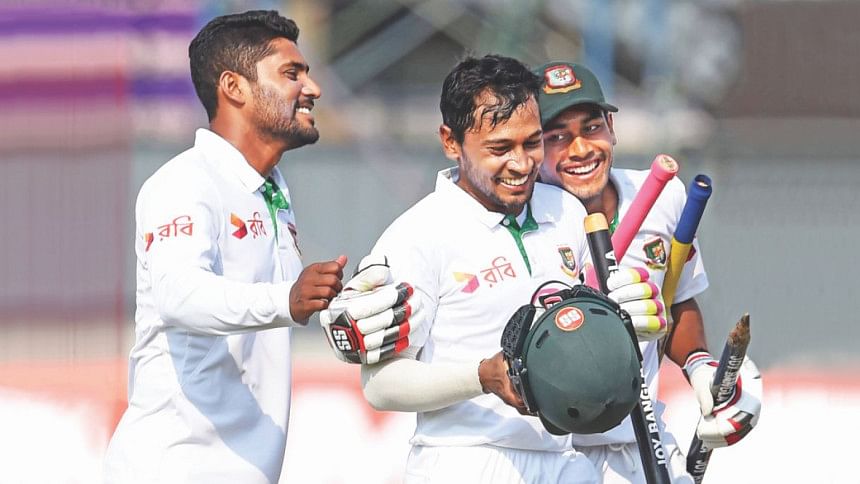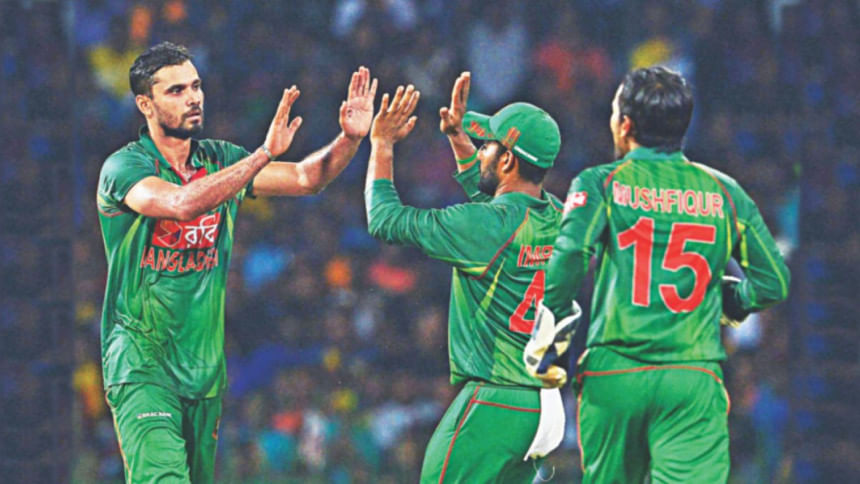Tigers learn the art of the fightback

When the tour of Sri Lanka started, 1-1 draws in each of the three formats, which Bangladesh achieved by winning the second of the two T20Is on Thursday, would have seemed like a highly optimistic forecast.
Yet, after a total of 15 days of cricket and countless hours of practice squeezed into 31 days starting with the first Test in Galle from March 7 till this Thursday, Bangladesh have walked away with a share of the spoils in every format -- an achievement worth writing home about on a tour of Sri Lanka, one of the more difficult assignments in world cricket, not least because of the heat which was particularly sapping on this tour.
With the acclimatisation and conditioning challenges that touring sides encounter in contrast to the familiarised home team, three series split down the middle would ordinarily point to a moral victory for the visitors. However, in this case the second ODI being washed out after Sri Lanka scored 311 in Dambulla on March 28 -- no team has successfully chased more than 300 in Sri Lanka -- will leave a question mark over the outcome of the ODI series, especially after the way Bangladesh folded in the third ODI when chasing 281. Speculation about that match will rage on as long as there are cricket fans on both sides.
THE GALLE HUMILIATION AND THE AWAKENING
But what it says in the books is Bangladesh fought back from a terrible performance in the crushing 259-run defeat in Galle, when five wickets were surrendered in the first hour of the fifth day, to win a first-ever Test against Sri Lanka at the P Sara Oval in Colombo, which also happened to be their 100th Test. They then continued their momentum to win the first ODI by 90 runs with a perfect performance.
If there is one term that can be affixed to this tour, it is body language. After the first ODI, coach Chandika Hathurusingha said that the biggest change he noticed since the first Test was in body language. It was the humiliation in Galle, one in a long line of fifth-day surrenders this season that made the team close ranks and look within. In an age where the coach and backroom staff often do the thinking for the players, the Galle humiliation forced Mushfiqur Rahim and his men to start a custom of players-only meetings before each match, and the results were there to see from P Sara and beyond -- particularly in the field.
“[Closed door meeting among only the players] makes a difference although we didn't do it today,” said Shakib Al Hasan after the second T20I was won by 45 runs. “I think we should do it whenever we need to. It helps because many players can air their feelings freely. People feel lighter, and we have seen that it helps us on the field.”
Whereas previous tours and series had their supporters bemoaning missed chances, Bangladesh consistently and comfortably outperformed their opponents on the field, with the exception of the third ODI when Sri Lanka's effort just about exceeded Bangladesh's sustained brilliance. The few catches that were dropped were off very difficult opportunities, with the exception of Mashrafe Bin Mortaza's drop off Upul Tharanga in the second T20I.
The results of the body language uptick had a more profound effect -- the will to fight not just between matches but within them. Even in the third ODI, which after the Galle debacle was Bangladesh's second-worst result on tour, the bowlers and fielders fought back after leaking 76 runs in the first 10 overs to concede just 204 runs in the next 40.
But it is the will to fight back from setbacks in results that will be the takeaway from this tour, and it was in plentiful evidence at both ends of the tour. In the Tests they had to contend with someone like Rangana Herath, the best fifth-day bowler in the world who had just obliterated them in Galle, to chase a tricky 191-run target on the fifth day. Other than a few post-tea jitters when the target was within touching distance, Bangladesh passed with flying colours.
In the T20Is, they had to face the threat that is Lasith Malinga, who bowled his yorkers with real venom in Sri Lanka's six-wicket victory on Tuesday. In the next match on Thursday, far from being cowed by the threat and emboldened by the desire to give outgoing captain Mashrafe a winning send-off, they actually went after Malinga, particularly Soumya Sarkar, who seems to be truly rediscovering the form that made him a sensation in 2015's home successes. Malinga did come back with his fourth international hattrick late in the innings, but that just limited the damage done to Sri Lanka.

WINDS OF CHANGE
This tour was not without its moments of turmoil. Mahmudullah, after a prolonged lean patch that made him a virtual walking wicket to short balls and swinging deliveries in Tests, was dropped from the second Test and there was a ridiculous to-ing and fro-ing about sending the senior batsman home for the duration of Bangladesh's 100th Test, with the uncertainty being generated mostly by the Bangladesh Cricket Board president with the first of his numerous instances of micro-management on this tour.
Established number three batsman Mominul Haque was another, if much more inconspicuous, exclusion from the Test squad. Unlike Mahmudullah however, Mominul cannot stake his claims in other formats so it will fall upon the coach and the team management to see to it that a batsman who averages in the high forties in Tests does not fall by the wayside.
The most high-profile of the changes however was the retirement of Mashrafe from T20Is. More than his retirement -- a change that was in the offing as he will likely not be there to lead the team in the next World T20 -- it was the nature of the announcement that has raised eyebrows. An unselfish cricketer like Mashrafe announced his retirement at the toss of the first T20I, thereby making the series all about his exit. The behind-the-scenes manoeuvrings that led to Mashrafe making the announcement in such a way will likely be one of the unknowns from this tour that may come to light later.
Overall, it has been a positive 31 days for Bangladesh, and their best away tour till date.
“We played with more freedom in the second T20, compared to the first game. I think it is a positive sign. We have to play like this in T20s. We made huge improvements in the Test series, after losing the first game. In ODIs, we showed the consistency of the last couple of years. We didn't bat well in the third ODI, but overall we had a mindset change in Tests and T20s. We don't often win like this abroad,” said Shakib on Thursday.
They have not won like this often away, till this tour. Their fans will hope that this was the first instance of a rising curve.

 For all latest news, follow The Daily Star's Google News channel.
For all latest news, follow The Daily Star's Google News channel. 



Comments